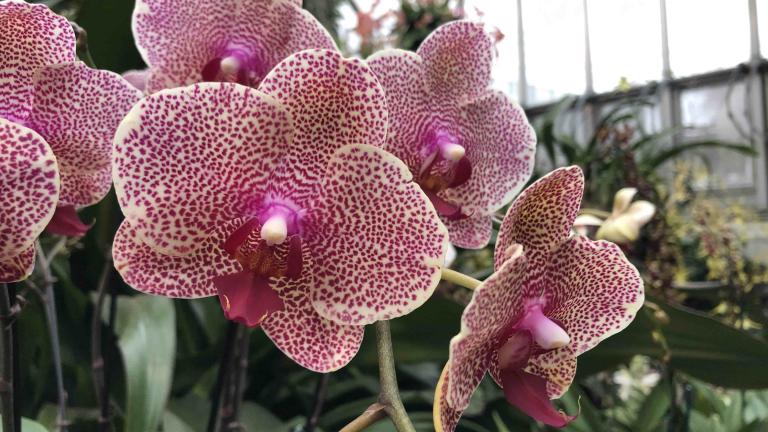 A sculpture representing scientist Carolus Linnaeus, “father of modern taxonomy,” at Chicago Botanic Garden. (Patty Wetli / WTTW News)
A sculpture representing scientist Carolus Linnaeus, “father of modern taxonomy,” at Chicago Botanic Garden. (Patty Wetli / WTTW News)
Visitors flocked to the Chicago Botanic Garden over the recent holiday weekend, burying their noses in aromatic blooms, snapping selfies in front of picturesque waterfalls and sculptures, and filing away ideas for DIY home landscaping projects.
That’s the front-facing side of the garden’s mission. Behind the scenes, a team of research scientists is focused on saving the planet’s plants from a quickening pace of extinction.
This less publicized aspect of the garden’s work is about to experience a growth spurt.
A newly announced gift of $21 million from the Negaunee Foundation — the largest gift in the garden’s history — will advance the garden’s conservation and eco-restoration efforts on a scale not previously possible.
“I think among the staff here, there was both joy and relief,” said Kayri Havens, chief scientist and Negaunee vice president of science.
Relief, she explained, because “it makes our work much more secure” in the current volatile economy, and joy “that we can tackle some new challenges and step up our game.”
Given that plants make up 60% of the endangered species list but only receive 3% of the funding — “a miserable state of affairs,” Havens said — the significance of the Negaunee gift takes on added significance.
Among the projects that will benefit from the infusion of funds is the garden’s contribution to the groundbreaking development of plant “studbooks,” a term some people might more readily associate with horse farms.
In the same way that inbreeding leads to problems among humans and other animals, the lack of a diverse gene pool in a botanic garden’s collection can result in plants that are less fit or unable to produce pollen or seeds, Havens said.
Whereas accredited zoos maintain meticulous studbooks for breeding, particularly when it comes to endangered species, and routinely arrange mating exchanges in order to ensure healthy populations, botanic institutions haven’t followed suit. But they are beginning to now.
Chicago Botanic is leading a pilot to create a process that will mimic zoos’ careful mating practices, and it’s drawing on the expertise of its sister institution, Brookfield Zoo, to adapt tools and techniques for rare and endangered plant species.
An early trial involves Hawaii’s alula plant (Brighamia insignis), also known as the vulcan palm or “cabbage on a stick.” Found only on the islands of Kauaʻi and Niʻihau, alula has gradually diminished in numbers due to the loss of its primary pollinator (a hawk moth) and natural disasters including landslides and hurricanes. Today, alula is considered functionally extinct in the wild.
Hawaii’s botanic collections had become so inbred that plants could no longer reproduce, Havens said, but by plotting out a studbook and identifying compatible specimens housed in other gardens’ collections, scientists have been able to restore fertility.
“This (Negaunee) gift will allow us to continue that work,” Havens said.
 (Chicago Botanic Garden / Facebook)
(Chicago Botanic Garden / Facebook)
Along with furthering its establishment of studbooks, Chicago Botanic Garden also plans to use the Negaunee gift to hire a curator to oversee its ever expanding seed and pollen banks.
Collecting seeds in places like Hawaii, Guam and Southeast Asia has become urgent, as isolated island populations of plants are among the most at risk of extinction. Closer to home, Chicago Botanic banks seeds from the upper Midwest.
Like the studbooks, the seed and pollen banks offer a “genetic safety net” for plants, but not to create “museum pieces” for display purposes only, Havens said.
The ultimate goal is always to reestablish plants in the wild, she said.
Agencies including the Illinois Department of Natural Resources and the Forest Preserve District of Cook County rely on seeds collected by Chicago Botanic to restore and maintain native habitat. Which is why one of the responsibilities for the new curator, whom Havens hopes to bring on board by early 2024, will be to ensure the viability of seeds stored in the garden’s vaults.
To help translate the garden’s plant science into actions that land managers can adopt, Chicago Botanic is also planning on hiring a new director of conservation impact, Havens said, and will redouble efforts to give people hands-on experience in managing natural areas and set them on a career path in plant conservation.
“Botany expertise is being lost at universities and land management agencies,” Havens said. “There hasn’t been a concerted effort to bring on the next generation.”
To that end, the garden’s natural areas internship program and a graduate program run in partnership with Northwestern University are also likely to receive boosts from the Negaunee gift.
“This gift will enable so much good work,” Havens said. “We’re over the moon here.”
Contact Patty Wetli: @pattywetli | (773) 509-5623 | [email protected]








